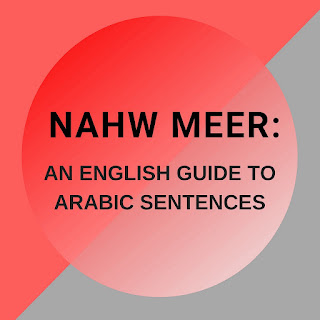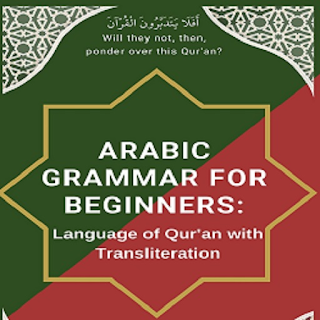Sarf and Nahw Summary: 2.0 - Waaw and Faa Conjunction Particles
2.0 – Waaw and Faa Conjunction Particles
Section 2.1 - Waaw (وَ) Types and Examples
There are many waaw types but the most frequently used waaws in Al-Qur’an are given below.
a. Waaw of addition/conjunction (وَاوُ الْعَطْف): Single word on single, plural word on plural, compound on the compound, sentence on sentence. For example, مُحَمَّدٌحَاضِرٌ وَعَلِيٌّ غَائبٌmeaning Mohammed is present and Ali is absent.
b. Waaw (وَ) of Resumption/continuation (اِسْتِئنَافِيَة): A compound whose first part sentence is not connected by meaning and flexibility to the second one as in ثمَّ قَضَى أجلاً وأجلٌا مُسمّىً from Surah An’aam Ayah 2, meaning “He decided on a time and a time is set”.
c. Waaw of Response وَاوُ الْجَزَاء: Gives imperfect verb accusative and Un (أَنْ) is muqaddar (predestined) because of waaw as in
طَالِعُ الْكُتُبِ وَتَسْتَفِيْدَ خَيْرٌ لَكَ مِنَ الْلَهْوِ
Read books, and you will benefit better from having fun The waaw here is the waaw of response.d. Waaw of state (وَاوُ الْحَالِيَة): Comes before Nominative sentence or Verbal sentence before which a definite noun was there and it provides the state/condition of the previous rule/action. For example:
جَاءنِيْ زَيْدٌ وَ هُوَ مَسْرُوْرٌ
Zaid came to me in the condition that he was happy
زَارَنِيْ زَيْدٌ وَهُوُ سَعِيْدٌ
Muhammad visited me while he was happy
e. Waaw of association (وَاوُ الْمَعِيَة): For example:
جَاءَ الْبَرْدُ وَالْجُبَّاتِ
The cold came with coats (waaw here is in the meaning of “with” مَعَ)
أَأَنْتُمْ أَنْزَلْتُمُوهُ مِنَ الْمُزْنِ أَمْ نَحْنُ الْمُنْزِلُونَ (56:69) Waqia
Is it you who brought it down from the clouds, or is it We who bring it down?
f. Supplemental/redundant waaw (وَاوُ الْزَائِدَة) used for the beauty and scale of the phrase.
سَألْتَمُوْنِيْهَا
You asked me
g. Waaw of oath (وَاوُ الْقَسْمِيَة/ الْجَارَّة): Implies oath, for example, وَاللهِ by God,
Waaw Halia حَالِيَة (first waaw) and Waaw instenafia إسْتِئنَافِية (second waaw) combined example:
وَيَحْيَى مَنْ حَيَّ عَنْ بَيِّنَةٍ وَإِنَّ اللَّهَ لَسَمِيعٌ عَلِيمٌ(8:42)
And those who lived [in faith] would live upon evidence; and indeed, Allah is all Hearing and Knowing.
۞۞۞
Section 2.2 - Faa (فَ) Types
Faa فَ is useful for arranging (التَّرْتِيْب)and gathering (الجَمْع)and implies that the following action has happened directly (without break).
1. The particle fa (فَ) is a connective particle that is translated as "and", "then" or "so". The particle is used as a prefix and connects words and phrases using different types of syntactic relations.
2. There's also the coordinating conjunction (عَاطِفَة) which is a commonly used additive particle meaning “and”.
3. A result particle (اَلْفَاء فِيْ جَوَابِ الشَرَطِ) that is used in response to a condition شَرَط.
4. Fa can also be a supplemental particle (اَلْفَاء زَائِدَة) as in أَفَلَا meaning “so then do not”. If a faa comes with a hamza then hamza is brought in the beginning always.
5. Faa can be a particle of cause (اَلْفَاء سَبَبِيَة) similar to Waaw haalia (explained before).
6. When used as a conjunction, the particle fa functions in a similar way to wa ("and”) So there are many types of fa فَ depending on the context.
Faa is used in several places such as Answer to Amr أَمْرْ (command), Answer to nahi نَهِي (Negative of all kinds), Answer to Nafi نَفِيْ(Negative), Answer to istefham إسْتِفْهَام(interrogation), Idha إذَا shartia (condition) and Tamanni لَيْتَ (desire), etc.
۞۞۞
Section 2.3 - Faa Examples
1. Additive/conjunctive: اَلْفَاء حَرْف عَطْف
Here al-faa’ might be an equivalent to the additive ‘and relation’. However, it mostly expresses the result or effect of a preceding clause.
Examples:
Ad-duha 93:9/10
فَأَمَّا الْيَتِيمَ فَلَا تَقْهَرْ
So as for the orphan,
do not oppress [him].
وَأَمَّا السَّائِلَ فَلَا تَنْهَرْ
And as for the petitioner
do not repel [him].
2. Redundant faa for emphasis: اَلْفَاء زَائِدَة لِلتَّوْكِيْد
It is of two kinds:
A) one comes with a nominal clause implying the meaning of the condition
B) The second is fully redundant and used for the beauty and scale of the phrase
یَفُوْزُ فَلَهُ الَّذِي جَائِزَةُ
Whoever wins gets a prize
وَرَبَّكَ فَكَبِّرْ
And proclaim the greatness of your Lord
وَثِيَابَكَ فَطَهِّرْ
And purify your robes
3. The faa of cause: اَلْفَاء السَّبَبِيَة
The causal faa’ comes in a few places, “that is” preceded by pure negation, pure demand, interrogation, prohibition, prayer (invocation), excitation, wishing (potation), anticipating, e.g. (of negation)
(Faatir 35:36)
لَا يُقْضَى عَلَيْهِمْ فَيَمُوتُوا
[Death] is not decreed for them so they may die
4. Resumption Particle: اَلْفَاء اِسْتِئنَافِيَة
The inception faa’ اِسْتِئنَافِيَة اَلْفَاء with it coupling is incorrect to connect what is before to what is after since meaning is different. Here al-faa’ takes the adversative meaning of but or and.
لَم يَفْعَلْ أخُوْكَ فالْيَتَسَافِرْهُ
If your brother does not, then let him go
7:11 Al A’raf
فَسَجَدُوا إِلَّا إِبْلِيسَ لَمْ يَكُنْ مِنَ السَّاجِدِينَ
So, they all prostrated—but not Iblees
5. Response faa: اَلْفَاء جَزَائِيْة فِيْ جَوَابِ شَرَط
Al-faa’ that connect the condition with its answer; it is called the answering faa’ for response to a condition
.
6:17 Al-An’aam
وَإِنْ يَمْسَسْكَ اللَّهُ بِضُرٍّ فَلَا كَاشِفَ لَهُ إِلَّا هُوَ
And if Allah punishes you with any harm, then there is no remover of it except Him.
6. Sorting faa (tarteeb): اَلْفَاء فَصِيْحِيَة
An’aam 6:102
ذَٰلِكُمُ اللَّهُ رَبُّكُمْ ۖ لَا إِلَٰهَ إِلَّا هُوَ ۖ خَالِقُ كُلِّ شَيْءٍ فَاعْبُدُوهُ ۚ وَهُوَ عَلَىٰ كُلِّ شَيْءٍ وَكِيلٌ
That is Allah, your Lord; there is no deity except Him, the Creator of all things, so worship Him. And He is Disposer of all things.
7. The connective faa’ (faa al raatib): اَلْفَاء رَاتِب
It is an inactive particle.
2) Al-Baqara 2:31
قُلْ إِنْ كُنْتُمْ تُحِبُّونَ اللَّهَ فَاتَّبِعُونِي يُحْبِبْكُمُ اللَّهُ
8. Al-faa’ of what is before it: اَلْفَاء حَسْب ما قَبْلھَا
19:23 (Maryam)
فَأَجَاءَهَا الْمَخَاضُ إِلَى جِذْعِ النَّخْلَةِ
And the pains of childbirth drove her to the trunk of a palm tree
۞۞۞





Comments